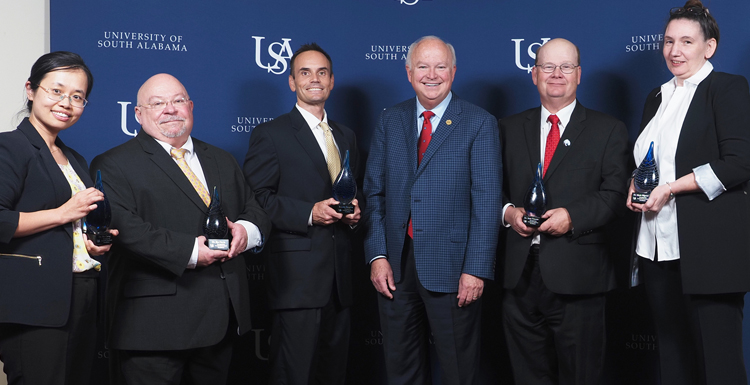South Researchers Honored
Posted on October 26, 2023

Five University of South Alabama faculty members were honored Oct. 24 at the 2nd Annual Technology and Research Showcase for their research. Dr. Marie Migaud, professor of pharmacology and oncology; Dr. Na Gong, professor of electrical and computer engineering; Dr. Jordan Shropshire, professor of information systems and technology; Dr. Sean Powers, professor of marine and environmental sciences and senior marine scientist at the Dauphin Island Sea Lab; and Dr. James Davis, professor of chemistry; have made advances in artificial intelligence, anti-aging biochemistry, ionic liquids, and protecting our environment and computer systems.
“We are blessed to have faculty here at South who are very interested in research and who have brought millions of dollars in research funding to South,” said Dr. Michael Chambers, associate vice president for research at USA. “Our external funding has doubled since 2018. This does not happen without faculty taking the time to file grant requests to compete for funding from various sources.”
Attending the event were local and state leaders, including Innovate Alabama CEO Cynthia Crutchfield and Alabama Finance Director Bill Poole.
“What an incredible asset USA is to the state of Alabama. I don’t think people realize what a powerhouse this University is,” Poole said. “Research in higher education is one of the most important things we can dedicate ourselves to. It’s the key to solving our problems.”
This year’s honorees and a summary of their research:
Dr. Marie Migaud, professor of pharmacology and oncology
Our bodies are made of trillions of cells regulated by complex chemical pathways that help balance our body’s internal operations. But as we age, our cells start losing the ability to regulate this balance, leading to age-associated diseases. One key chemical involved in the aging process is a molecule called NAD+. NAD+ is a biomolecule found in every living cell in the human body, and NAD+ is known to decrease as we age. Decreases in NAD+ are observed in arthritis, heart disease, Alzheimer’s disease and cancer. Because increasing NAD+ through diet alone is not possible, biochemists have been working to find new ways to increase NAD+ in cells and reduce the hallmarks of aging. With the NAD+ market valued at $500 million and the global anti-aging market reaching $60 billion in value, the global race is on to develop safe treatments to restore NAD+, and at the center of this race is Migaud and her team at the University of South Alabama. Specializing in the field of nucleic acid biology, Migaud and her team have developed advanced chemical solutions to increase NAD+ in cells, with lead compounds safely increasing NAD+ levels in cell and animal studies. Migaud has created novel compounds that can increase NAD+ better than currently available compounds. Work in her research lab at the Mitchell Cancer Institute has pioneered new chemical reactions to create these key compounds, and Migaud recently received a $1 million grant from NASA to reduce the risks of space travel on astronaut health. Her research has led to over 100 research articles, five awarded patents and multiple patent applications. In addition to her work in the NAD+ field, she has helped accelerate the use of biologically based chemistry solutions to replace harsh, toxic chemical reactions, creating greener, renewable, sustainable processes. Through corporate partnerships, academic collaborations and government funding, Migaud and her team are building the biochemical tools to redefine sustainable biochemistry and reduce the effects of aging.
Watch the video.
Dr. Na Gong, professor of electrical and computer engineering
Artificial intelligence, or AI, is increasingly influencing our world. Advances in learning algorithms and predictive models have led to an explosion of innovation. AI is projected to contribute nearly $16 trillion to the global economy by 2030. And AI use in healthcare promises to revolutionize patient care and personalized medicine. AI can be used to identify cancer, predict patient outcomes and enable personalized treatments. But AI has some significant drawbacks that limit its medical uses. One limitation is that AI algorithms utilize remote, complex computers accessed through the internet to analyze data, then transmit the results back to the user. Transferring large amounts of medical data can be slow and may pose privacy concerns, and the need for large computers can be costly and limit applications. But Dr. Gong and her team at the University of South Alabama are bringing AI closer to the end user through innovative use of “Edge AI.” Edge AI is AI that operates on the edge of the network, usually performing computations on the device where the data is created, like a smart phone or a smart watch. This reduces the need to transmit private data between devices or use complex computer networks. Through a $6 million dollar grant provided by the National Science Foundation, Gong’s team is developing the hardware, software and research infrastructure to create new wearable technologies incorporating Edge AI. In collaboration with multiple universities, Gong’s team is developing a smart wearable device that can be used to predict the onset of diabetic complications by providing AI-guided blood-glucose monitoring without the need for finger pricks or blood draws. This low-cost device can provide personalized medical assistance. And because it does not require internet access or immediate physician care, it can bring technology to rural communities to improve treatment. And this is only the beginning. The Edge AI tools and infrastructure developed by Gong and her team will be used to provide solutions that will one day be readily available on your phone or watch.
Watch the video.
Dr. Jordan Shropshire, professor of information systems and technology
Every day we connect to a global network of computers and servers to send and receive information. The interconnected nature of our digital world has led to the constant threat of criminal intrusion and cyberattacks. But the cost of cyberattacks is compounded when they infiltrate and compromise some of our most sensitive data networks. Defense systems, satellite and space networks and aviation systems all operate under an increased threat of evolving cyberattacks. In a global cybersecurity arms race, the speed, versatility and robustness of solutions are fundamental to protect critical infrastructure and data. Researchers and developers at the University of South Alabama’s School of Computing have stepped up to meet this growing cyberthreat head on. USA’s School of Computing was designated as a National Center of Academic Excellence in Cyber Defense by the National Security Agency and the Department of Homeland Security. Dr. Jordan Shropshire, professor of information systems and technology, focuses on developing innovative solutions to emerging challenges in cybersecurity. Shropshire’s real-world experience in information security, data center management and cloud computing have made him a sought-after partner by defense agencies such as the US Army, US Air Force and US Navy, as well as Fortune 500 companies such as Cisco, Raytheon and Leidos. His solutions deliver ready-to-implement applications. Shropshire investigates technological advances within the cybersecurity field to develop new, out-of-the-box methods for decreasing system vulnerability and increasing resilience while under attack. And in the rapidly evolving cybersecurity landscape, identification of new novel methods is key to staying ahead of threat actors. Shropshire specializes in the implementation of “low-stack solutions,” where the operating system meets the hardware, leading to integrated systems with reduced vulnerability. His designs are resilient and include guaranteed system recovery. By providing robust, cutting-edge information system designs and solutions, Shropshire’s cybersecurity solutions protect some of our most sensitive systems from threats, using integrated applications to ensure safety and bring peace of mind.
Watch the video.
Dr. Sean Powers, professor of marine sciences and senior marine scientist, Dauphin Island Sea Lab
Alabama’s waterways house some of the most biodiverse ecosystems in the U.S., and they are a major source of state revenue. It is estimated that Alabama’s water-based recreation industry bring in over $1 billion a year for Alabama. Mobile is uniquely located on Mobile Bay at the foot of the Mobile-Tensaw Delta. Preserving this natural treasure and the marine life it sustains has long been recognized as a priority for the state. But how do we measure marine diversity and ecosystem sustainability when so much of it lies below the water? Powers and his research team have the answer. His research focuses on marine fish and invertebrates and their habitats to help direct conservation and restoration efforts of Alabama’s recreational and commercial fisheries. University of South Alabama researchers have pioneered the use of advanced technologies to help make direct observations of fish and invertebrates in their marine habitats. Underwater cameras, remotely operated vehicles, satellite tracking of fish, seafloor mapping and artificial intelligence are cost-effective methods used by Dr. Powers and his team to monitor marine life. Direct observation of Alabama’s marine life provides an accurate census of fish populations, which can help identify areas in need of conservation and restoration. Using these methods, he has published over 150 peer-reviewed scientific articles and has been awarded over $46 million in grant funding for his work. And the conservation work of Dr. Powers doesn’t stop at research and data collection. He currently serves on the Board of Trustees for Alabama’s Forever Wild Land Trust Board. He advises several Gulf States, including Alabama, on fisheries management and conservation activities. And his work has been featured on the Discovery Channel, National Geographic, PBS, CNN and local media. As advocates for Alabama’s clean waters and marine habitats, Powers and his research team provide the critical information to help build sustainable solutions to maintain Alabama’s marine life.
Watch the video.
Dr. James Davis/Professor of Chemistry
One leading concern of this century is the long-term global impact of excess carbon dioxide on the air and water quality, weather patterns and delicate ecosystems of our planet. Industrialization and innovation have increased the quality of our lives, but they have been fueled by the combustion of fossil fuels, leading to a build-up of carbon dioxide in our atmosphere at a faster rate than ever. Industrial scale production of carbon dioxide requires an industrial scale solution that avoids further air or groundwater pollution. Researchers at the University of South Alabama, led by Davis, have created ionic liquids capable of removing carbon dioxide from the air through direct air capture. Ionic liquids are salts that are liquids at the temperature they are used, and ionic liquids have a variety of uses in environmentally benign processes. Using ionic liquids, carbon dioxide is selectively sequestered, or captured, from the air by passing through a scrubbing chamber, thereby reducing carbon dioxide levels while leaving no air pollutants and no volatile chemicals. Davis and his research collaborators at the South Alabama Ionic Liquids Laboratory, or SAILL, have pioneered the use of ionic liquids to reduce carbon dioxide from industrial exhaust. And while this application can greatly impact our future carbon dioxide output, the uses of ionic liquids do not end with carbon dioxide capture from the air. Davis and SAILL have investigated this versatile family of compounds for use in battery development, military technologies, and medical treatment. To date, Davis has received over $6 million in research funding to advance the application of ionic liquids, and innovations by SAILL have accelerated due to growing commercial interest. The market for ionic liquids is projected to grow to approximately $4.5 billion by 2027. Collaborations with the U.S. Navy and engineering firms have transformed the foundational research by Davis into real-world solutions to many of the industrial-sized problems we face today. Innovation in ionic liquids taps into our greater potential for a better, cleaner tomorrow.
Watch the video.





